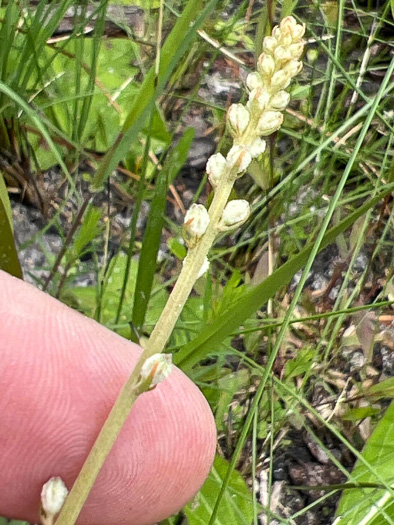Spermatophytes (seed plants): Angiosperms (flowering plants): Monocots: Dioscoreales
WEAKLEY'S FLORA OF THE SOUTHEASTERN US (4/24/22):
Aletris obovata
FAMILY
Nartheciaceae
Go to FSUS key
Dig deeper at SERNEC, a consortium of southeastern herbaria.
The hybrid of A. lutea with A. obovata is relatively frequent in the area of parental geographic overlap; it is intermediate, including in flower color, which is a creamy pale yellow, per Weakley's Flora (2022)
SYNONYMOUS WITH
PLANTS NATIONAL DATABASE:
Aletris obovata
FAMILY
Liliaceae
SYNONYMOUS WITH Floristic Synthesis of North America. BONAP (Kartesz, 2021)
Aletris obovata
SYNONYMOUS WITH Flora of North America
Aletris obovata
SYNONYMOUS WITH VASCULAR FLORA OF THE CAROLINAS (Radford, Ahles, & Bell, 1968) 041-20-002:
Aletris obovata FAMILY Liliaceae
SYNONYMOUS WITH Manual of the Southeastern Flora (Small, 1933, 1938)
Aletris obovata
COMMON NAME:
Southern White Colicroot
To see larger pictures, click or hover over the thumbnails.
Alan S. Weakley asw_178852321656815
April FL
Apalachicola National Forest
Flowers curve inward at the tip and are typically about as broad as long at maturity, per Atlantic Coastal Plain Wildflowers (Nelson, 2006).
WEAKLEY'S FLORA OF THE SOUTHEASTERN US (4/24/22):
Aletris obovata
FAMILY
Nartheciaceae
SYNONYMOUS WITH
PLANTS NATIONAL DATABASE:
Aletris obovata
FAMILY
Liliaceae
SYNONYMOUS WITH
Floristic Synthesis of North America. BONAP (Kartesz, 2021)
Aletris obovata
SYNONYMOUS WITH
Flora of North America
Aletris obovata
SYNONYMOUS WITH
VASCULAR FLORA OF THE CAROLINAS (Radford, Ahles, & Bell, 1968) 041-20-002:
Aletris obovata
FAMILY
Liliaceae
SYNONYMOUS WITH
Manual of the Southeastern Flora (Small, 1933, 1938)
Aletris obovata
If a search such as "Carex leptalea var. leptalea" doesn't deliver the results you want, try "Carex leptalea".
Or, to minimize chances of a misspelling, try just "Carex le".
Less is more: If "pencil flower" doesn't deliver the results you want, try "pencil".


